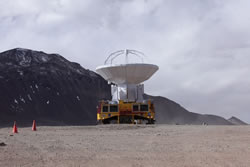Japanese ALMA antenna became the first to arrive at the ALMA 5000 m site
| Science

apanese ALMA antenna became the first to arrive at the ALMA 5000 m site. The ALMA (Atacama Large Millimeter/submillimeter Array) astronomical observatory has taken another step forward and upward, as one of its state-of-the-art antennas was carried for the first time to the 5000m plateau of Chajnantor, in the Chilean Andes, on the back of a custom-built giant transporter, on 2009 September 18 (JST). The antenna, which weighs about 100 tons and has a diameter of 12 meters, was lifted to the high-altitude Array Operations Site, where the extremely dry and rarefied air is ideal for ALMA's observations of the universe.
The conditions at the Array Operations Site on Chajnantor, while excellent for astronomy, are also very harsh. Only half as much oxygen is available as at sea level, making it very difficult to work there. This is why ALMA's antennas are assembled and tested at the lower 2900 m altitude of the ALMA Operations Support Facility (OSF). It was from this relatively hospitable base camp that the ALMA antenna began its journey to the high Array Operations Site.